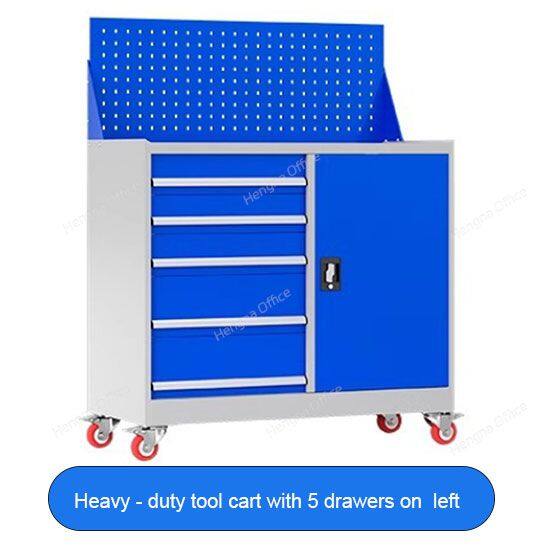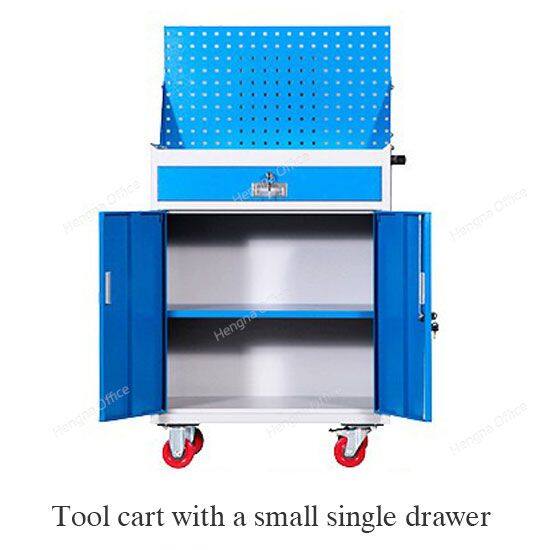Home > Blog > Transform Your Workspace: How to Use a Heavy Duty Mobile Tool Cart for Efficient Tool Storage
-
 Sarah
Hi there! Welcome to my shop. Let me know if you have any questions.
Sarah
Hi there! Welcome to my shop. Let me know if you have any questions.
Your message has exceeded the limit.

Transform Your Workspace: How to Use a Heavy Duty Mobile Tool Cart for Efficient Tool Storage
2025-10-16 17:40:52
Enter the heavy duty mobile tool cart—a simple yet powerful solution that can completely transform your workspace and optimize your workflow. This guide will show you how to leverage this versatile tool storage system to create a more efficient, organized, and productive work environment.
The Hidden Costs of Poor Tool Management
Before we dive into the solution, let’s understand the real impact of disorganized tools in a professional setting:
Time Wastage
Search Time: Workers spend an average of 15-20 minutes per day searching for tools
Project Delays: Missed deadlines due to tool unavailability
Overtime Costs: Additional labor expenses from inefficiency

Financial Impact
Tool Replacement: Lost or damaged tools cost businesses thousands annually
Reduced Output: Lower productivity means fewer completed projects
Quality Issues: Using improper tools leads to rework and customer dissatisfaction
Safety Concerns
Accident Risks: Cluttered workspaces increase injury potential
Tool Damage: Poor storage leads to premature tool failure
Compliance Issues: Safety violations from improper tool storage
Understanding the Heavy Duty Mobile Tool Cart Advantage
A heavy duty mobile tool cart is more than just a storage box—it’s a comprehensive workflow optimization system designed specifically for demanding work environments. Let’s explore what makes these carts so effective:
Core Components
Multiple Drawers: Various sizes for different tool types
Pegboard System: Vertical storage for frequently used items
Heavy-Duty Casters: Smooth mobility across various surfaces
Locking Mechanism: Security for valuable tools
Steel Construction: Durability for industrial environments
Key Differentiators
Unlike traditional tool storage, mobile tool carts offer:
Mobility: Move your entire tool collection where needed
Accessibility: Tools organized for quick retrieval
Scalability: Expand as your tool collection grows
Versatility: Adapt to different work environments and tasks
Step 1: Assess Your Current Workspace
Before implementing a mobile tool cart system, take time to evaluate your current situation:
Workspace Analysis
Layout: Map your current workspace and tool locations
Traffic Flow: Identify how workers move through the space
Tool Usage: Determine which tools are used most frequently
Pain Points: Note current frustrations and inefficiencies
Tool Inventory

Create a comprehensive list of all tools in your workspace:
Hand Tools: Wrenches, screwdrivers, pliers, etc.
Power Tools: Drills, saws, grinders, etc.
Measuring Instruments: Calipers, levels, tape measures
Specialized Equipment: Trade-specific tools and devices
Consumables: Fasteners, adhesives, etc.
This assessment will help you choose the right tool cart and develop an effective organization system.
Step 2: Choose the Right Heavy Duty Mobile Tool Cart
Not all tool carts are created equal. Selecting the right one for your needs is crucial for success:
Size Considerations
Small Carts: Best for limited spaces or specialized tool sets
Medium Carts: Ideal for general workshop use
Large Carts: Perfect for comprehensive tool collections or multiple users
Essential Features to Look For
Drawer System:
Ball-Bearing Slides: Smooth operation even with heavy loads
Weight Capacity: Drawers that support your heaviest tools
Soft-Close Mechanism: Prevents damage and noise
Mobility Features:
Industrial Casters: Designed for rough surfaces
Locking Wheels: Stability during use
360° Swivel: Easy maneuverability in tight spaces
Construction Quality:
Steel Frame: Durability for demanding environments
Powder Coating: Resistance to chemicals and abrasion
Reinforced Corners: Extra strength at stress points
Security Options:
Central Locking: One key secures all compartments
Tamper-Resistant Design: Deters unauthorized access
Keyed Alike: Multiple carts can use the same key
Step 3: Implement an Effective Organization System
Once you have your tool cart, the real transformation begins. Here’s how to organize for maximum efficiency:
Categorization Strategy
Group tools by:
Function: All measuring tools together, all cutting tools together
Frequency: Daily use items in most accessible locations
Project: Tools specific to certain types of work
Size: Large items in bottom drawers, small items in top drawers
Drawer Organization Techniques
Use Dividers and Inserts:
Adjustable Dividers: Create custom-sized compartments
Foam Inserts: Cut to fit specific tools perfectly
Magnetic Strips: Hold metal tools securely in place
Label Everything:
Drawer Labels: Clear identification of contents
Tool Silhouettes: Visual guides for tool placement
Color Coding: Different colors for different tool categories
Pegboard Optimization
Maximize your vertical space:
Frequently Used Tools: Hang items you reach for constantly
Custom Layout: Arrange hooks and holders for your workflow
Quick Access: Ensure tools can be grabbed with one hand
Step 4: Integrate with Your Workflow
A tool cart is only effective if it fits seamlessly into how you work:
Positioning Strategy
Workstation Proximity: Keep carts close to where tools are used
Traffic Flow: Position carts to minimize walking distance
Multiple Stations: Use several carts for different work areas
Usage Protocols
Establish clear guidelines:
Tool Checkout System: Track who has which tools
Return Procedures: Ensure tools are returned to proper locations
Maintenance Schedule: Regular cleaning and organization checks
Mobility Best Practices
Lock When Stationary: Prevent rolling during use
Clear Pathways: Ensure easy movement between work areas
Weight Distribution: Load carts evenly for stability
Step 5: Maintain and Optimize
Organization isn’t a one-time event—it’s an ongoing process:
Daily Maintenance
Return Tools: Put everything back after use
Quick Clean: Wipe down surfaces and remove debris
Check Organization: Ensure everything is in its place
Weekly Reviews
Assess Usage: Determine if organization system is working
Adjust as Needed: Move tools based on actual usage patterns
Clean Thoroughly: Deep clean drawers and surfaces
Monthly Optimization
Inventory Check: Account for all tools and equipment
System Evaluation: Look for opportunities to improve
Training: Ensure all users understand proper procedures
Real-World Benefits and ROI
Productivity Improvements
Time Savings: Reduce tool search time by up to 80%
Increased Output: Complete 20-30% more work in same time
Better Quality: Proper tools lead to better work results
Financial Returns
Reduced Costs: Lower tool replacement and labor expenses
Increased Revenue: More capacity means more billable work
Competitive Advantage: Faster turnaround attracts more business
Workplace Enhancements
Safety Improvements: Fewer accidents and injuries
Employee Satisfaction: Less frustration, more pride in workspace
Professional Image: Impresses clients and stakeholders
Success Stories: Transformations in Action
Manufacturing Facility
A medium-sized manufacturing plant implemented mobile tool carts across their production floor:
Results: 25% increase in productivity, 40% reduction in tool-related delays
ROI: Full payback within 4 months
Construction Company
A residential construction company equipped each crew with a mobile tool cart:
Results: 30% faster project completion, 50% reduction in lost tools
ROI: 200% return in first year
Automotive Repair Shop
A busy auto shop reorganized using mobile tool carts:
Results: 35% more cars serviced daily, 60% improvement in technician satisfaction
ROI: 300% return within 6 months
Common Pitfalls to Avoid
1. Underestimating Capacity
Choose a cart that can accommodate your current tools plus room for growth.
2. Poor Organization Planning
Take time to plan your organization system before implementing it.
3. Neglecting Maintenance
Regular cleaning and organization are essential for long-term success.
4. Inadequate Training
Ensure all users understand how to properly use and maintain the system.
5. Ignoring Workflow Integration
The tool cart must fit how you actually work, not how you think you should work.
Transforming your workspace with a heavy duty mobile tool cart is one of the most impactful investments you can make in your business’s efficiency and productivity. By following the steps outlined in this guide—assessing your needs, choosing the right cart, implementing an effective organization system, integrating with your workflow, and maintaining the system—you can create a workspace that not only looks professional but actually performs at the highest level.
The benefits are clear: significant time savings, reduced costs, improved safety, and enhanced employee satisfaction. In today’s competitive business environment, these advantages can make the difference between merely surviving and truly thriving.
Don’t let disorganized tools hold your business back any longer. Take the first step today toward a more efficient, productive, and profitable workspace with a heavy duty mobile tool cart. Your bottom line—and your employees—will thank you for it!
Tags: Transform Your Workspace, Heavy Duty Mobile Tool Cart, Heavy Duty Mobile Tool Cart for Efficient Tool Storage

